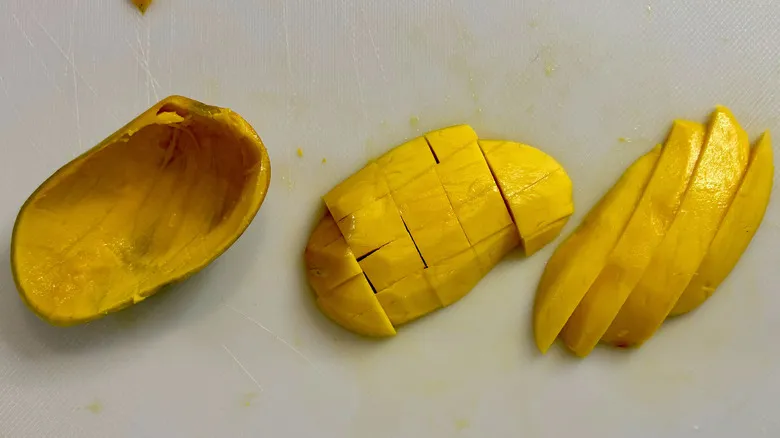Tools you will need
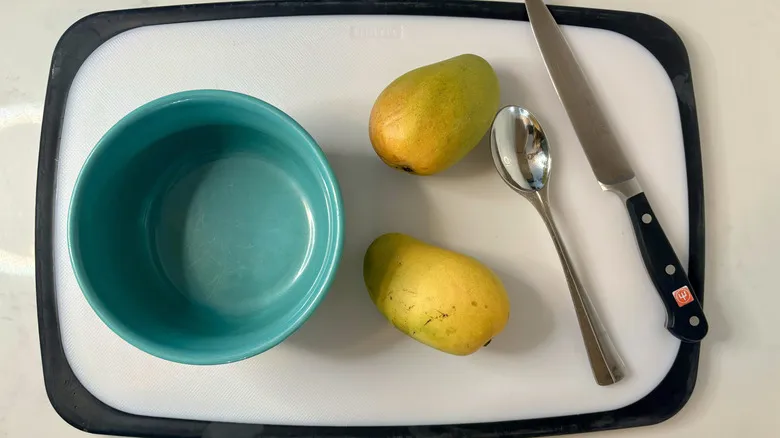
As previously stated, there's no need to purchase any specialized tools. All you require is a mango, a cutting board, and a bowl to hold the diced mango. It might also be helpful to have a kitchen towel on hand, as mangoes tend to be quite juicy.
In addition to these items, you'll need a sharp chef's knife. It's important that your knife is sharp, as it should easily cut through the mango's skin. Contrary to popular belief, a sharp knife is actually safer than a dull one. Lastly, if you plan to peel the mango, a fruit peeler will be necessary. We recommend using a Y-peeler due to the thickness of the mango skin.
Picking a ripe mango

To fully enjoy your mango, it's essential to choose one that is ripe. The mango season runs from May to September, which is when you'll find the best quality fruit. Since mangoes come in various colors, relying solely on their hue isn't the best method for selection. Instead, we suggest checking the firmness of the mango. Like many fruits, a mango is ripe when it yields slightly to pressure. If you encounter a mango that feels rock-hard, it is under-ripe and should be set aside for later.
If you happen to purchase unripe mangoes, simply leave them at room temperature for a few days. Check on them regularly until they reach ripeness. Mangoes will continue to ripen on the counter; all you need to do is be patient.
Common mango-cutting mistakes
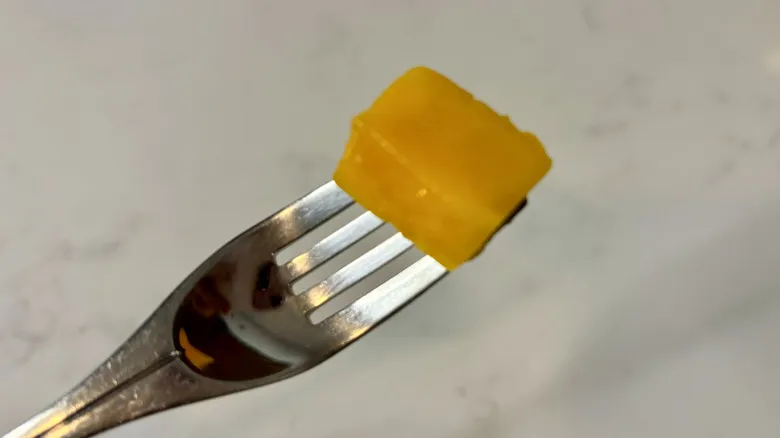
One of the most frequent errors when handling mangoes is attempting to slice through the pit. While mango pits may not be as easily recognizable as those of other fruits, they are present and can hinder your ability to cut the mango if you're not cautious. Make sure to slice off to the side rather than down the center of the fruit; this will create space for the pit.
With this in mind, when you cut the mango, most of the edible fruit will come from the sections known as the "cheeks." Mangoes are not perfectly round; they have an oblong shape with sides that are both wider and narrower, creating protrusions. Some people mistakenly believe that starting with the narrow protruding side is the best approach, but this will only result in a small, pit-filled piece of mango. Instead of relying on all-mango cutting techniques, we recommend removing the wide "cheeks" first before making any additional cuts. This method provides you with two generous pieces of mango to enjoy.
Scoring your mango

Begin by slicing off the cheeks of your mango. To enhance stability, you may want to trim a small piece from the bottom of the mango. Next, position the mango upright and carefully cut off the cheeks, making your cuts slightly off-center rather than directly down the middle. This technique will provide a better grip on the center and yield two mango wedges.
Take one of the mango wedges with the flesh facing up and use a sharp knife to make vertical cuts down the center. Be sure to apply enough pressure to penetrate the flesh without cutting through the tough skin.
Then, create horizontal cuts at your preferred intervals to form a grid of mango squares. Repeat this process with the second wedge.
Next, turn the mango peel inside out so that the cubes are exposed on the outside.
To remove the mango chunks from the skin, you can gently press from the bottom with your thumb to pop them out. Alternatively, you can use the knife to cut away each cube. In the end, you will have perfectly cubed mango pieces.
Using a spoon
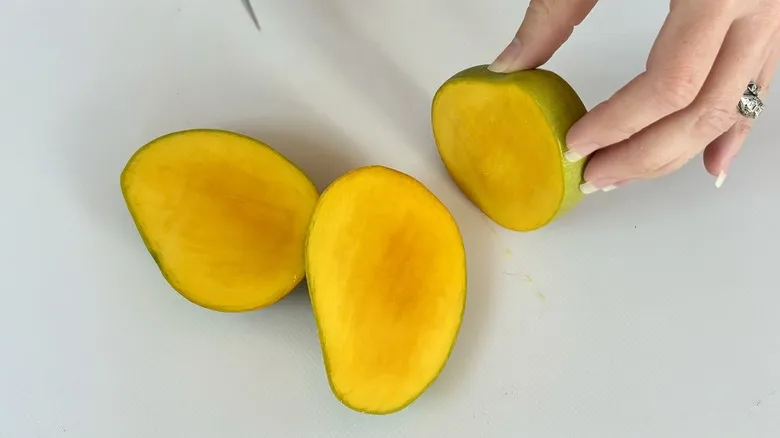
Position your mango upright and slice off the cheeks. Instead of cutting directly down the center, make your cuts slightly off-center. This will provide a better grip for the center and yield two mango wedges.
Helena Nichols/ Chowhound
At this point, you have two choices: you can either score the mango with your knife, as described above, or leave it intact. If you choose to score it, take one of the mango wedges and apply enough pressure with your knife to cut through the flesh without piercing the skin. You can create slices or cubes.
Helena Nichols/ Chowhound
Once you’ve shaped the mango to your liking or opted to keep it whole, use a spoon to scoop out the fruit pieces.
Helena Nichols/ Chowhound
If your mango slice remains whole, you can either scoop out pieces to eat directly or use your spoon to extract the entire chunk of fruit, working your way around the half to separate the flesh from the skin, similar to how you would with an avocado.
Peeling method
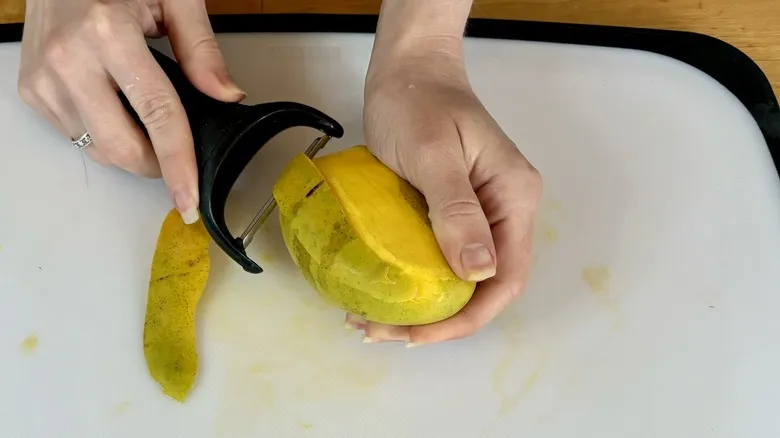
Hold the mango in your non-dominant hand. Using your Y-shaped peeler, start peeling the skin off in long strips. Continue rotating the mango until all the skin is removed. Once done, set the mango on the cutting board.
With a sharp knife, cut away the cheeks of the mango. If the mango is particularly fleshy, you can also trim off the two small ends that remain.
Lay the mango cheeks flat side down and cut them into your desired shape, whether that be slices or cubes of any size or form.
How to store a mango
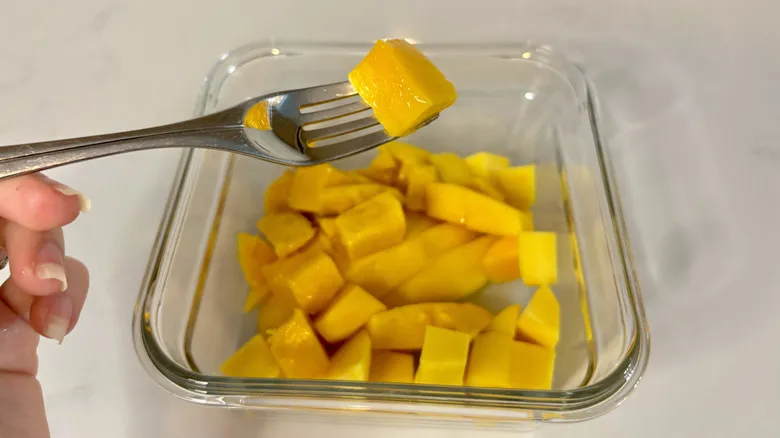
Mangoes can be preserved in various ways. Unripe mangoes should be kept on the countertop until they achieve optimal ripeness. Once ripe, they can either be sliced or stored in the refrigerator for up to five days to slow down further ripening.
After cutting, mangoes can also be refrigerated. They should be stored in an airtight container and kept in the fridge for a few days.
Additionally, mangoes can be frozen by placing them in an airtight container or bag, ensuring to remove as much excess air as possible. They can remain frozen for approximately six months.
Recipes that use mango
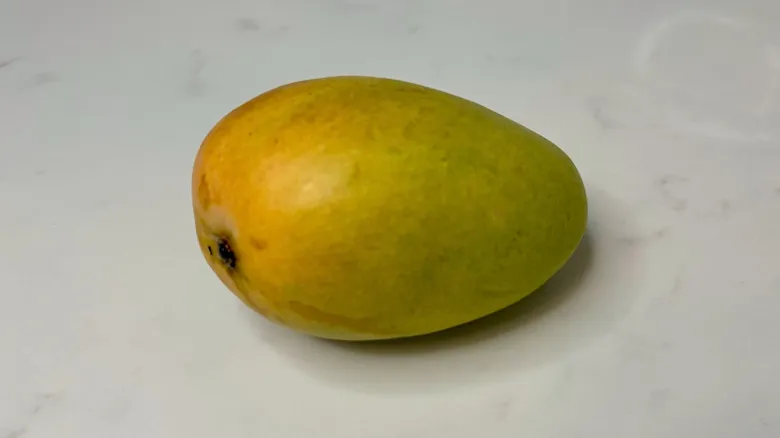
Mangoes are delightful and can be savored on their own, but they also lend themselves to a variety of tasty recipes. Mango Sago is a refreshing tapioca pudding dessert that’s perfect for warm days.
If you're in the mood for a mango-inspired treat and enjoy a bit of culinary experimentation, give these peelable mango gummies a try. However, mangoes aren't limited to sweets—adding diced mango to your next poke bowl creates a lovely combination of sweet and savory flavors.
Recommended

Slow Cooker Liners Are Convenient, But Are They Safe?

How To Reheat McDonald's Fries For First-Fry Flavor

How To Clean Clams For A Grit-Free Dish

How To Make The Best Fried Rice You've Ever Eaten
Next up

